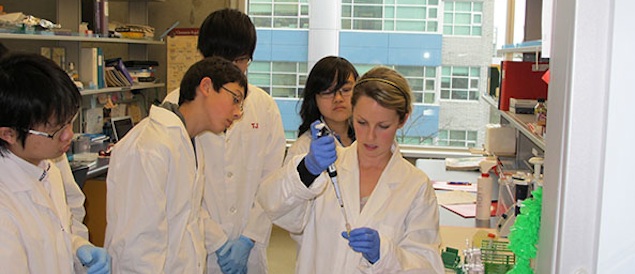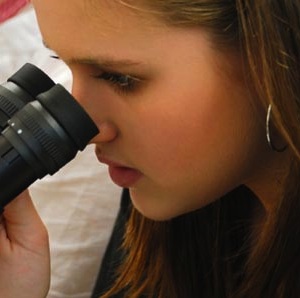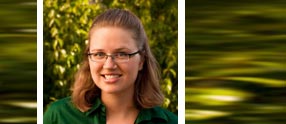 |
UBC Science Connect |
| NEWS AND EVENTS FOR UBC SCIENCE ALUMNI | VIEW HTML VERSION |

|
UBC Graduate Students Put a Criminal Spin on Life Science OutreachA researcher is found dead hunched over her lab bench, and seven suspects are in custody. Now it’s up to 30 high school students to determine who killed her. That’s the premise for an innovative science outreach program hosted by the Graduate Student Association (GSA) at UBC’s Life Sciences Institute (LSI). The one-day, hands-on lab is aimed at grade ten, eleven and twelve students in the hopes of sparking their interest in science as a career. As a UBC graduate student Caylib Durand, along with post-doctoral fellow Santiago Ramon-Garcia and the first Executive Committee of the LSI-GSA, saw an opportunity to invite students to participate in a fun and interesting event that would afford them an inside look at a professional and active scientific environment. “There is so much incredible research happening at the Life Sciences Institute, but there’s limited public access,” says Durand. “We felt we had a unique opportunity to give back to the community through education.” |


FestEVOLVE 2011: Voyages in Evolution
Join us in celebrating evolution! Themed activities, talks, and tours will take place throughout the month, celebrating past, current, and future evolutionary research. Events and activities are geared to all ages, and there's sure to be something for all walks of life!
Bacterial Production of Hydrogen: A Potential Biofuel Mountain Formation on Io Deepwater Horizon Controlling Chemistry with Light and Force |
 |

Genes Give Fungus Ability to Turn Poison into Nectar
The genome of the fungus that helps mountain pine beetles infect and kill lodgepole pines has been decoded in a UBC study. Also known as blue stain fungus for the stain it leaves in the wood of infected trees, Grosmannia clavigera is carried to the host trees by pine beetles and weakens the trees' natural defense system, allowing pine beetles to feed and reproduce in the tree bark. A successful beetle-fungus attack ultimately causes tree death. Now, researchers from UBC and the BC Cancer Agency's Genome Sciences Centre have conducted a detailed genome analysis and identified genes in Grosmannia clavigera that are responsible for the fungus's ability to bypass the lodgepole pine's natural fungicide – and use it as a carbon source for fungal growth. "We found that the fungus cannot only survive, but thrive when exposed to the normally fungicidal resin chemicals of pines," says co-author Joerg Bohlmann, a professor in the Michael Smith Laboratories. "In a way, it's like these genes give the fungus the ability to turn poison into nectar." |

Share Your Science Experience at Beyond the BSc |
|

|
Hey Science alumni! We need you to share your career stories with current Science students at this flagship event for undergrads. Whether you ended up in research, opening your own company, working abroad, or flying to the moon--we want to showcase where your BSc took you! Join us March 17 for this evening of information and networking. Interested in participating? Please contact Kimberley Rawes at kimberley.rawes@ubc.ca |

Global Map of Surface Permeability Could Bring New Insights Into Water Supply |
||
|
UBC researchers have produced the first map of the world outlining the ease of fluid flow through the planet's porous surface rocks and sediments. The maps and data, published in Geophysical Research Letters, could help improve water resource management and climate modelling, and eventually lead to new insights into a range of geological processes. "This is the first global-scale picture of near-surface permeability, and is based on rock type data at greater depths than previous mapping," says Tom Gleeson, a postdoctoral researcher with the Department of Earth and Ocean Sciences.  |
 |
Using recent world-wide lithology (rock type) results from researchers at the University of Hamburg and Utrecht University in the Netherlands, Gleeson was able to map permeability across the globe to depths of approximately 100 metres. Typical permeability maps have only dealt with the top one to two metres of soil, and only across smaller areas. "Climate models generally do not include groundwater or the sediments and rocks below shallow soils," says Gleeson. "Using our permeability data and maps we can now evaluate sustainable groundwater resources as well as the impact of groundwater on past, current and future climate at the global scale." |

Are You a Wise Science Alumna? Share Your Story! |
|

|
Women in Science and Engineering wants you to share your experiences as a female science undergraduate at WISE. This event highlights opportunities for female undergrads to interact with successful and accomplished women in science. We want to celebrate the visibility and importance of females in science and engineering! Join us March 23 for this evening of information and networking. Interested in participating? Please contact Kimberley Rawes at kimberley.rawes@ubc.ca |

Wave-Generated 'White Hole' Boosts Hawking Theory |
||
|
A team of UBC physicists and engineers have designed an experiment featuring a trough of flowing water to help bolster a 35-year-old theory proposed by eminent physicist Stephen Hawking. In 1974, Hawking predicted that black holes--often thought of having gravitational pulls so strong that nothing escapes from them--emit a very weak level of radiation. According to the theory, pairs of photons are torn apart by a black hole's gravitational field--one photon falls into the black hole, but the other escapes as a form of radiation.  |
 |
In results outlined in the latest issue of Physical Review Letters, a team of UBC researchers led by international postdoctoral researcher Silke Weinfurtner put the test to Hawking's theory by creating a 'white hole' in a six-metre-long flume of flowing water. Placing an airplane wing-shaped obstacle in the path of the flowing water created a region of high-velocity flow which blocked surface waves, generated downstream, from traveling upstream. The obstruction simulated a white hole, the temporal reverse of a black hole. "While this creative simulation obviously doesn't prove Hawking's theory, it does show that his ideas apply broadly," says UBC theoretical physicist William Unruh. |

Genes Contribute to Sockeye Mortality |
||
|
Fraser River sockeye salmon with a certain genomic profile are more likely to die before spawning, contributing to the recent declines in British Columbian salmon, according to a new study by UBC and Fisheries and Oceans Canada. For the study, researchers conducted non-lethal biopsies and then tracked adult salmon in the ocean and river to determine if successful and unsuccessful spawners were physiologically distinguishable.  |
 |
The study, published in the journal Science, used gene expression profiling to assess physiological differences among fish. It found that ocean-tagged salmon showing a certain gene expression signature were 13.5 times more likely to die before spawning, and river-tagged salmon showing the same expression signature were 50 per cent more likely to die before spawning. "We demonstrated that the survivorship of salmon can be predicted based on gene expression, over 200 kilometers before salmon enter the river," said Scott Hinch, an associate member of the department of Zoology, who was a co-author on the study. |

Take Your Kids on a Tech Trek in Computer Science |
|

|
UBC Computer Science is now hosting Tech Trek Saturdays. The program brings high-school students to campus for a half-day of computer science activities, including programming robots, learning to design programs and games, and listening to real industry professionals from Electronic Arts and Pixar talk about the cutting edge of technology--all in a fun, friendly environment. Parents are welcome to attend. |

Mountain Glacier Melt to Contribute 12 Centimetres to World Sea-Level Increases by 2100 |
||
|
Melt off from small mountain glaciers and ice caps will contribute about 12 centimetres to world sea-level increases by 2100, according to UBC research published in Nature Geoscience. The largest contributors to projected global sea-level increases are glaciers in Arctic Canada, Alaska and landmass bound glaciers in the Antarctic. Glaciers in the European Alps, New Zealand, the Caucasus, Western Canada and the Western United Sates--though small absolute contributors to global sea-level increases--are projected to lose more than 50 per cent of their current ice volume.  |
 |
The study modelled volume loss and melt off from 120,000 mountain glaciers and ice caps, and is one of the first to provide detailed projections by region. Currently, melt from smaller mountain glaciers and ice caps is responsible for a disproportionally large portion of sea level increases, even though they contain less than one per cent of all water on Earth bound in glacier ice. "There is a lot of focus on the large ice sheets but very few global scale studies quantifying how much melt to expect from these smaller glaciers that make up about 40 percent of the entire sea-level rise that we observe right now," says Valentina Radic, a postdoctoral researcher with the Department of Earth and Ocean Sciences and lead author of the study. |

Science Alumni and Friends Reconnect at EOS Round Up |
|

|
More than 200 UBC people gathered at this year's EOS Roundup alumni reception. Geologists, alumni, environmentalists, adventurers, corporate representatives, academics, and science students came together to network and have a little fun. Greg Dipple, Head of the Department of Earth and Ocean Sciences, brought guests up to speed on the construction of the new Earth Sciences Building, the future of the Geological Field Work Project, and new labs within Geochemistry at UBC. For more information about this and other alumni events, please contact Kim Duffell, Science Alumni Relations Manager, at kim.duffell@ubc.ca. |


Nadya Ogloff, |
 |

AAAS Recognizes UBC Plant Researchers Bohlmann, Douglas
UBC researchers Joerg Bohlmann and Carl Douglas have been elected as fellows of the American Association for the Advancement of Science. Bohlmann is cited for distinguished contributions in the field of plant biology, particularly for investigations into the genomics and biochemistry of plant defence against insects. Douglas is recognized for his research into plant cell wall biosynthesis, forestry tree genomics, and development of Populus as a model woody plant system. The AAAS is an international non-profit organization dedicated to advancing science around the world by serving as an educator, leader, spokesperson and professional association. UBC Computer Scientist Honored by ACM Marine Metabolite Hunter Nabs UBC's Top Research Prize UBC Astronomers Help Crunch New Planck Satellite Data UBC Marine Virologist Named Huntsman Award Recipient |

 |
|

|
» 1996
Fifteen years ago, the Pacific Institute for the Mathematical Sciences, a premier international research facility headquartered at UBC, was established. It received an unprecedented $10 million in funding from U.S. and Mexican agencies. |

 | ||
You're receiving Science Connect because, as a UBC Science alumni or supporter, you've given the university permission to contact you. And while we hope you find our e-magazine interesting, we take your privacy seriously, and have made it easy for you to: | ||
 |
||

 |
| © 2011, UBC Faculty of Science | Privacy | Update your contact information |

